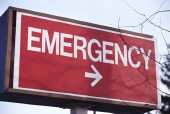Most ERs Not Fully Prepared for Pediatric Patients
Only 6 percent had all the recommended equipment, survey finds.
By Randy Dotinga
HealthDay Reporter
|
E-mail this article
Subscribe to news
Printer friendly version
|

(SOURCES: Karen Sheehan, M.D., medical director, Injury Prevention and Research, Children's Memorial Hospital, and medical director, Injury Free Coalition for Kids in Chicago; James G. Linakis, M.D., Ph.D., research associate, Injury Prevention Center, Rhode Island Hospital, pediatric emergency physician, Hasbro Children's Hospital, and associate professor, emergency medicine and pediatrics, Brown Medical School, Providence, R.I.; Dec. 3, 2007, statement, American College of Emergency Physicians; December 2007 Pediatrics)
MONDAY, Dec. 3 (HealthDay News) -- Parents who find themselves rushing a child to the nearest emergency room might want to keep a new finding in mind: Only 6 percent of emergency rooms in the United States have all the equipment they should have on hand to treat youngsters.
Many hospitals declined to respond to the survey, however, so the UCLA researchers suspect the true number of centers that don't meet recommendations might be even higher.
Among other deficiencies, hospitals failed to have a variety of devices geared toward infants and newborn babies, according to the survey, which is published in the December issue of Pediatrics.
The survey doesn't address the issue of whether hospitals with less appropriate equipment provide substandard services to kids, noted Dr. Karen Sheehan, medical director of Injury Prevention and Research at Children's Memorial Hospital in Chicago. "But if you don't have equipment small enough for a child, it is not a big leap to think this may affect a child's care."
Surveys were sent in 2003 to 5,144 emergency rooms around the United States, asking about what equipment was geared toward the proper treatment of children. The researchers wanted to know if the hospitals were following 2001 guidelines regarding pediatric care that were released by the American Academy of Pediatrics and the American College of Emergency Physicians.
According to the study, only 11 percent of emergency room visits by kids occur in hospitals specifically designed to treat children. The rest end up in regular emergency rooms.
The emergency rooms contacted by the researchers only returned 1,489 surveys, a response rate of 29 percent. Officials at 59 percent of the emergency room departments that responded said they were aware of the 2001 guidelines, but many didn't follow them completely.
Just half of the hospitals surveyed had so-called laryngeal mask airways on hand for children. The masks, equipped with tubes, allow patients to breathe when their airway may be obstructed.
The study authors noted that the survey response rate was low and pointed out that hospitals that did respond tended to deal with higher numbers of pediatric patients. So, the authors wrote, it's possible that emergency rooms as a whole may be doing a worse job of following the guidelines.
The authors add that "much work is left to be done to improve pediatric preparedness of [emergency rooms]."
The American College of Emergency Physicians was quick to respond to the 6 percent statistic, which it called "misleading."
In a statement released Monday, the group cited studies that "show 95 percent of children who come to emergency departments are treated successfully and released. This raises the question of whether the list of equipment is too extensive, since emergency departments use it as a guideline, and the universal good outcomes seem to indicate that physicians are making the necessary adjustments."
Sheehan also noted there are some caveats to the study. "In all fairness, many guidelines come out each year, so it is challenging to keep up with them all," she said.
Also, some hospitals may see comparably few young patients each day, and "it may be hard to devote limited resources to serving relatively few children," she added.
Still, she said, "we need to assure we can provide excellent emergency care for children in whatever type of emergency department they are seen."
Parents have their own role to play when it comes to emergency care, said Dr. James G. Linakis, a pediatric emergency physician at Hasbro Children's Hospital in Providence, R.I. "They should carefully evaluate what kind of emergency services are available to them. The time to do that is before their child needs an emergency department."
The best choice is typically an emergency room that sees the most children, he said. "If there are pediatric emergency medicine specialists on staff, that can be a real plus. If not, they should look for an emergency department staffed by physicians trained in emergency medicine. Often, a brief discussion with the child's primary-care provider will help parents determine which emergency department is most suitable for emergency care of their child."
More information
Learn more about kids and the emergency room from kidshealth.org. 
Copyright © 2007 ScoutNews, LLC. All rights reserved. 
HealthDayNews articles are derived from various sources and do not reflect federal policy. healthfinder.gov does not endorse opinions, products, or services that may appear in news stories. For more information on health topics in the news, visit the healthfinder.gov health library.